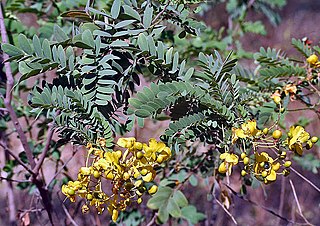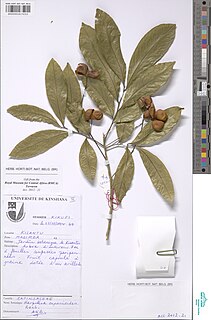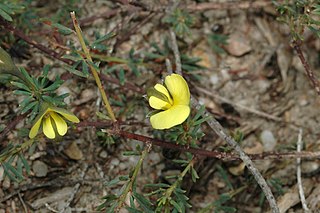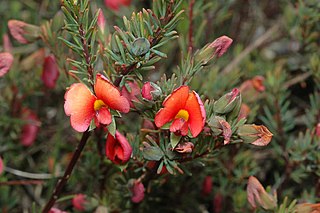
Lotus berthelotii is a flowering plant endemic to the Canary Islands of Spain, in the genus Lotus of the pea family Fabaceae. Among its common names are lotus vine flower, parrot beak, pelican beak, and coral gem. This plant is widely cultivated but is either extinct in the wild or persists as a few individuals. In 1884 it was already classed as "exceedingly rare" and plant collection probably hastened its decline.

Cassia fistula, commonly known as golden shower, purging cassia, Indian laburnum, or pudding-pipe tree, is a flowering plant in the subfamily, Caesalpinioideae of the legume family, Fabaceae. The species is native to the Indian subcontinent and adjacent regions of Southeast Asia. It ranges from eastward throughout India to Myanmar and Thailand and south to Sri Lanka and southern Pakistan. It is a popular ornamental plant and is also used in herbal medicine. It is both the national tree and national flower of Thailand. It is the state flower of Kerala in India. It is the provincial flower of North Central Province in Sri Lanka.

Lathyrus japonicus, the sea pea, beach pea, circumpolar pea or sea vetchling, is a species of flowering plant in the legume family Fabaceae, native to temperate coastal areas of the Northern Hemisphere and Argentina.

Albizia julibrissin, the Persian silk tree or pink silk tree, is a species of tree in the family Fabaceae, native to southwestern and eastern Asia.

Astragalus newberryi, is a flowering plant in the family Fabaceae, native to the western United States from Idaho to New Mexico and California. A variety is found in the Death Valley area and the eastern Mojave Desert in California and Nevada. It grows in rocky and gravelly areas between 1,300–2,350 metres (4,270–7,710 ft) elevation.

Sorbus commixta, the Japanese rowan, is a species of flowering plant in the family Rosaceae, native to Japan, Sakhalin, and the Korean island of Ulleungdo.

Senna auriculata is a leguminous tree in the subfamily Caesalpinioideae. It is commonly known by its local names matura tea tree, avaram or ranawara, or the English version avaram senna. It is the State flower of Telangana. It occurs in the dry regions of India and Sri Lanka. It is common along the sea coast and the dry zone in Sri Lanka.

Cassia grandis, one of several species called pink shower tree, and known as carao in Spanish, is a flowering plant in the family Fabaceae, native to the neotropics, that grows up to 30 m (98 ft). The species is distributed from southern México, to Venezuela and Ecuador. It grows in forests and open fields at lower elevations, and is known to be planted as an ornamental. In at least Costa Rica, its pods are stewed into a molasses-like syrup, taken as a sweetener and for its nutritional and medicinal effects, called Jarabe de Carao.
Cassia sieberiana, the drumstick tree, is a tree in the family Fabaceae native to Africa. It ranges from 10–20 metres in height and has very bright yellow flowers. It is used for multiple medical purposes in Africa and is found in the secondary jungle of a forest.
Borthwickia is genus of flowering plants, containing one species, Borthwickia trifoliata from Yunnan, China and Myanmar. The common name in Chinese is 节蒴木. It is a shrub or small tree with evergreen trifoliate leaves, whitish flowers clustered at the tip of the branches, with many stamens, and thin, knobbly, drooping fruits with many small red seeds.

Senna acclinis, commonly known as rainforest cassia or brush senna, is a species of flowering plant in the family Fabaceae and is endemic to near-coastal areas of eastern Australia. It is a shrub with pinnate leaves and bright golden yellow flowers in groups of two to five and long, narrow seed pods. It is similar to other species of Senna that are environmental weeds.

Zanthoxylum rhetsa, commonly known as Indian prickly ash, is a species of flowering plant in the family Rutaceae and occurs from India east to the Philippines and south to northern Australia. It is a deciduous shrub or tree with cone-shaped spines on the stems, pinnate leaves with between nine and twenty-three leaflets, panicles of white or yellowish, male and female flowers, followed by spherical red, brown or black follicles.

Senna pendula, also known as Easter cassia, climbing cassia, winter senna and valamuerto, is a plant of the Fabaceae family with a shrub habit that is native to South America. It used in various parts of the world as an ornamental plant and is an environmental weed in Australia. The flowers of this plant are yellow or greenish yellow and the name pendula means 'pendulous' or 'drooping'.

Harpullia cupanioides is a plant in the Sapindaceae family found in south east Asia: in the Andaman Islands, Assam, Bangladesh, Borneo, Cambodia, Yunnan, Hainan, Jawa, Laos, the Lesser Sunda Islands, Malaysia, Myanmar, New Guinea, Nicobar Islands, the Philippines, the Solomon Islands, Thailand, and Vietnam.
Gompholobium glutinosum is a species of flowering plant in the family Fabaceae and is endemic to the far west of Western Australia. It is an erect, openly-branched shrub with pinnate leaves with three to five leaflets, and yellow and red, pea-like flowers.

Gompholobium inconspicuum, commonly known as creeping wedge-pea is a species of flowering plant in the family Fabaceae and is endemic to south-eastern continental Australia. It is a prostrate or low-lying shrub with trifoliate leaves and pale lemon yellow to yellowish green, pea-like flowers.
Gompholobium oreophilum is a species of flowering plant in the family Fabaceae and is endemic to the north-west of Western Australia. It is an erect shrub with pinnate leaves with elliptic leaflets, and racemes of yellow to orange and creamy-yellow, pea-like flowers.

Gompholobium preissii is a species of flowering plant in the family Fabaceae and is endemic to the south-west of Western Australia. It is an erect shrub with pinnate leaves with five to fifteen leaflets, and yellow, red and orange, pea-like flowers.

Gompholobium uncinatum, commonly known as red wedge pea, is a species of flowering plant in the family Fabaceae and is endemic to eastern Australia. It is a small, low-lying shrub with trifoliate leaves, the leaflets linear to narrow lance-shaped, and red, or orange-red and yellow-green, pea-like flowers.

Gompholobium venustum, commonly known as handsome wedge-pea, is a species of flowering plant in the family Fabaceae and is endemic to the south-west of Western Australia. It is a slender, erect or sprawling shrub with pinnate leaves with fifteen to nineteen leaflets, and yellow or pink, pea-like flowers.





















